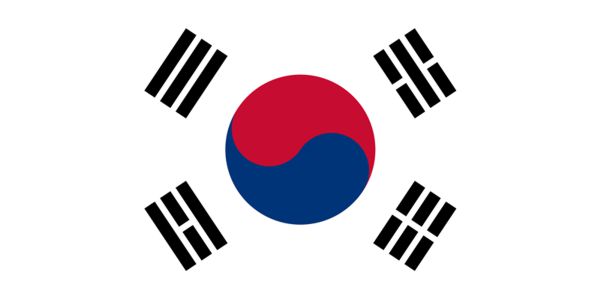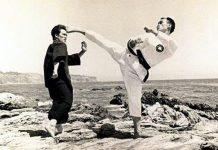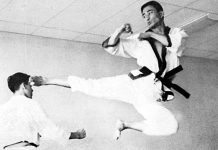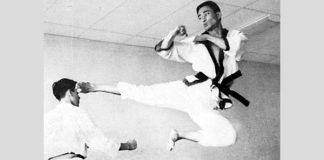 Taekwondo is a Korean martial art and the national sport of South Korea. In Korean, tae means “to strike or break with foot”; kwon means “to strike or break with fist”; and do means “way,” “method,” or “art.” Thus, taekwondo may be loosely translated as “the art of the foot and fist” or “the art of kicking and punching.”
Taekwondo is a Korean martial art and the national sport of South Korea. In Korean, tae means “to strike or break with foot”; kwon means “to strike or break with fist”; and do means “way,” “method,” or “art.” Thus, taekwondo may be loosely translated as “the art of the foot and fist” or “the art of kicking and punching.”
In 1989, taekwondo was the world’s most popular martial art, as measured by the number of practitioners. Its popularity has resulted in the varied development of the martial art into several domains: as with many other arts, it combines combat techniques, self-defense, sport, exercise, meditation, and philosophy. Taekwondo is also used by the South Korean military as part of its training. Gyeorugi (pronounced), a type of sparring, has been an Olympic event since 2000.
Formally, there are two main styles of taekwondo. One comes from the Kukkiwon, the source of the sparring system sihap gyeorugi which is now an event at the summer Olympic Games and which is governed by the World Taekwondo Federation (WTF). The other comes from the International Taekwon-Do Federation (ITF).
Separate from the various taekwondo organizations, there have been two general branches of taekwondo development: traditional and sport. The term “traditional taekwondo” typically refers to the martial art as it was established in the 1950s and 1960s in the South Korean military forces; in particular, the names and symbolism of the traditional patterns often refer to elements of Korean history. Sport taekwondo has evolved in the decades since then and has a somewhat different focus, especially in terms of its emphasis on speed and competition (as in Olympic sparring), whereas traditional taekwondo tends to emphasize power and self-defense. The two are not mutually exclusive, and the distinctions between them are often blurred.
Although there are doctrinal and technical differences between the two main styles and among the various organizations, the art in general emphasizes kicks thrown from a mobile stance, employing the leg’s greater reach and power (compared to the arm). The greatest difference between various styles, or at least the most obvious, is generally accepted to be the differing styles and rules of sport and competition. Taekwondo training generally includes a system of blocks, kicks, punches, and open-handed strikes and may also include various take-downs or sweeps, throws, and joint locks. Some taekwondo instructors also incorporate the use of pressure points, known as jiapsul, as well as grabbing self-defense techniques borrowed from other martial arts, such as hapkido and judo.
History
The oldest Korean martial art was an amalgamation of unarmed combat styles developed by the three rival Korean kingdoms of Goguryeo, Silla, and Baekje,[4] where young men were trained in unarmed combat techniques to develop strength, speed, and survival skills. The most popular of these techniques was subak, with taekkyeon being the most popular of the segments of subak. Those who demonstrated strong natural aptitude were selected as trainees in the new special warrior corps, called the Hwarang. It was believed that young men with a talent for the liberal arts may have the grace to become competent warriors. These warriors were instructed in academics as well as martial arts, learning philosophy, history, a code of ethics, and equestrian sports. Their military training included an extensive weapons program involving swordsmanship and archery, both on horseback and on foot, as well as lessons in military tactics and unarmed combat using subak. Although subak was a leg-oriented art in Goguryeo, Silla’s influence added hand techniques to the practice of subak.
During this time a few select Sillan warriors were given training in taekkyeon by the early masters from Koguryo. These warriors then became known as the Hwarang. The Hwarang set up a military academy for the sons of royalty in Silla called Hwarang-do, which means “the way of flowering manhood.” The Hwarang studied taekkyeon, history, Confucian philosophy, ethics, Buddhist morality, social skills and military tactics. The guiding principles of the Hwarang warriors were based on Won Gwang’s five codes of human conduct and included loyalty, filial duty, trustworthiness, valor and justice. Taekkyeon was spread throughout Korea because the Hwarang traveled all around the peninsula to learn about the other regions and people.
In spite of Korea’s rich history of ancient and traditional martial arts, Korean martial arts faded into obscurity during the Joseon Dynasty. Korean society became highly centralized under Korean Confucianism and martial arts were poorly regarded in a society whose ideals were epitomized by its scholar-kings. Formal practices of traditional martial arts such as subak and taekkyeon were reserved for sanctioned military uses. Civilian practice of taekkyeon, however, persisted into the 20th century.
Modern Development
During the Japanese occupation of Korea, all facets of Korean identity, including folk culture, language and history, were banned in an attempt to eradicate Korean culture and identity. Koreans were forced to adopt Japanese names and worship at Shinto shrines; Korean-language newspapers and magazines were banned; and during the war, hundreds of thousands of Koreans were forced into service to support Japanese war efforts. The Japanese efforts ranged from damaging alterations to monuments of Korean conquests/achievements to facile alterations such as changing the image of Korea’s traditional map from a tiger form to a rabbit form. The Japanese leadership of the time believed that by blocking the knowledge of younger Koreans, they could be led to believe they were not warriors in history but a passive race, and so the occupation would be easier. Historians of the time have stated, “Teachers of Japanese martial arts were the only approved instructors. This situation began the amalgamation of Japanese martial arts with the remaining fragments of the Korean systems still in general circulation.” Martial arts such as taekkyeon (or subak) were banned during this time.
During the occupation, Koreans who were able to study in Japan were exposed to Japanese martial artsin some cases receiving black belt ranking in these arts. Others were exposed to martial arts in China and Manchuria. When the occupation ended in 1945, Korean martial arts schools (kwans) began to open in Korea under various influences. There are differing views on the origins of the arts taught in these schools. Some believe that they taught martial arts that were based primarily upon the traditional Korean martial arts taekkyon and subak, or that taekwondo was derived from native Korean martial arts with influences from neighboring countries. Still others believe that these schools taught arts that were almost entirely based upon karate
In 1952, at the height of the Korean War, there was a martial arts exhibition in which the kwans displayed their skills. In one demonstration, Nam Tae Hi smashed 13 roof tiles with a punch. Following this demonstration, South Korean President Syngman Rhee instructed Choi Hong Hi to introduce the martial arts to the Korean army. By the mid-1950s, nine kwans had emerged. Syngman Rhee ordered that the various schools unify under a single system. The name “taekwondo” was either submitted by Choi Hong Hi (of the Oh Do Kwan) or Song Duk Son (of the Chung Do Kwan), and was accepted on April 11, 1955. As it stands today, the nine kwans are the founders of taekwondo, though not all the kwans used the name. The Korea Taekwondo Association (KTA) was formed in 1959/1961 to facilitate the unification. Shortly thereafter, taekwondo made its début worldwide with assignment of the original masters of taekwondo to various countries. Standardization efforts in South Korea stalled, as the kwans continued to teach differing styles. Another request from the Korean government for unification resulted in the formation of the Korea Tae Soo Do Association, which changed its name back to the Korea Taekwondo Association in 1965 following a change of leadership.
One source has estimated that taekwondo is practiced in 123 countries, with over 30 million practitioners and 3 million individuals with black belts throughout the world. The South Korean government has published an estimate that taekwondo is practiced by 70 million people in 190 countries. It is now one of only two Asian martial arts (the other being judo) that are included in the Olympic Games; it became a demonstration event starting with the 1988 games in Seoul, and became an official medal event starting with the 2000 games in Sydney. In 2010, taekwondo was accepted as a Commonwealth Games sport. It is therefore now included in all major multi-sport games except the Island Games.
Features
Taekwondo is known for its emphasis on kicking techniques, which distinguishes it from martial arts such as karate or southern styles of kung fu. The rationale is that the leg is the longest and strongest weapon a martial artist has, and kicks thus have the greatest potential to execute powerful strikes without successful retaliation. Historically, the Koreans thought that the hands were too valuable to be used in combat.
Taekwondo as a martial art is popular with people of both genders and of many ages. Physically, taekwondo develops strength, speed, balance, flexibility, and stamina. An example of the union of mental and physical discipline is the breaking of wooden boards, which requires both physical mastery of the technique and the concentration to focus one’s power.
A taekwondo student typically wears a uniform (dobok), often white but sometimes black (or other colors), with a belt (tti) tied around the waist. There are at least three major styles of dobok, with the most obvious differences being in the style of jacket: (1) the cross-over front jacket that resembles traditional Asian clothing, (2) the V-neck jacket (no cross-over) typically worn by WTF practitioners, and (3) the vertical-closing front jacket (no cross-over) typically worn by ITF practitioners. The belt colour and any insignia thereon (if any) indicate the student’s rank. In general, the darker the colour, the higher the rank. The school or place where instruction is given is called the dojang.
Although each taekwondo club or school will be different, a taekwondo student can typically expect to take part in most or all of the following:
- Learning the techniques and curriculum of taekwondo
- Both anaerobic and aerobic workout, including stretching
- Self-defense techniques (hosinsul)
- Patterns (also called forms, pumsae, teul, hyeong)
- Sparring (called gyeorugi, or matseogi in the ITF), which may include 7-, 3-, 2- and 1-step sparring, free-style sparring, arranged sparring, point sparring, and other types
- Relaxation and meditation exercises
- Throwing and/or falling techniques (deonjigi and tteoreojigi)
- Breaking (gyeokpa or weerok), using techniques to break boards for testing, training and martial arts demonstrations. Demonstrations often also incorporate bricks, tiles, blocks of ice or other materials. Can be separated into three types:
- Power breaking – using straightforward techniques to break as many boards as possible
- Speed breaking – boards are held loosely by one edge, putting special focus on the speed required to perform the break
- Special techniques – breaking fewer boards but using jumping or flying techniques to attain greater heights, distances, or to clear obstacles
- Exams to progress to the next rank
- A focus on mental and ethical discipline, justice, etiquette, respect, and self-confidence
Some schools teach the use of the “sine wave” when performing patterns; this involves raising one’s center of gravity between techniques, then lowering it as the technique is performed, producing the up-and-down movement from which the term “sine wave” is derived. Other schools teach that one’s center of gravity should remain generally constant throughout the performance of a pattern except where the pattern’s description states otherwise.
Organizations
Two of the most popular systems of taekwondo are named solely after their respective organizations, the International Taekwon-Do Federation (ITF) and the World Taekwondo Federation (WTF), which is closely associated with the Kukkiwon. The ITF was founded in 1966 by Choi Hong Hi. After Choi’s death in 2002, a number of succession disputes splintered the ITF into three different groups, all claiming to be the original. These three bodies are all private organizations. Two are located in Austria and one in Canada. The unofficial training headquarters of the ITF is located at the Taekwondo Palace in Pyongyang, North Korea, and was founded in the mid-1990s.
Four concrete paving bricks broken with a knife-hand strike. Breaking techniques are often practiced in taekwondo.The Korea Taekwondo Association Central Dojang was opened in South Korea in 1972. A few months later, the name was changed to the Kukkiwon. The following year, the World Taekwondo Federation was formed. The International Olympic Committee recognized the WTF and taekwondo sparring in 1980.
Although the terms “WTF” and “Kukkiwon” are often mistakenly used interchangeably, the Kukkiwon is a completely different organization which trains and certifies instructors and issues official dan and pum certificates worldwide. The Kukkiwon has its own unique physical building that contains the administrative offices of Kukkiwon (World Taekwondo Headquarters) in Seoul, South Korea and is the system of taekwondo. The WTF is a tournament committee and is not technically a style or a system.
There are many other private organizations, such as the World Traditional Taekwondo Union promoting the Songahm style of taekwondo and Rhee Taekwon-Do teaching the military style of taekwondo. Events and competitions held by private organizations are mostly closed to other taekwondo students. However, the WTF-sanctioned events allow any person, regardless of school affiliation or martial arts style, to compete in WTF events as long as he or she is a member of the WTF Member National Association in his or her nation, which is open to anyone to join. The major technical differences among these many organizations revolve around the patterns, called hyeong ?, pumsae ??, or teul ?, sets of prescribed formal sequences of movements that demonstrate mastery of posture, positioning, and technique, sparring rules for competition, and philosophy.
In addition to these private organizations, the original schools (kwans) that formed the organization that would eventually become the Kukkiwon continue to exist as independent fraternal membership organizations that support the WTF and the Kukkiwon. The official curriculum of the kwans is that of the Kukkiwon. The kwans also function as a channel for the issuing of Kukkiwon dan and pum certification (black belt ranks) for their members.
Ranks, Belts, and Promotion
Taekwondo ranks are typically separated into “junior” and “senior,” or “student” and “instructor,” sections. The junior section typically consists of ten ranks indicated by the Korean word geup ? (also Romanized as gup or kup). The junior ranks are usually identified by belts of various colors, depending on the school, so these ranks are sometimes called “color belts”. Geup rank may be indicated by stripes on belts rather than by colored belts. Students begin at tenth geup (often indicated by a white belt) and advance toward first geup (often indicated by a red belt with a black stripe).
The senior section is typically made up of nine ranks. These ranks are called dan ?, also referred to as “black belts” or “degrees” (as in “third dan” or “third-degree black belt”). Black belts begin at first degree and advance to second, third, and so on. The degree is often indicated on the belt itself with stripes, Roman numerals, or other methods; but sometimes black belts are plain and unadorned regardless of rank.
To advance from one rank to the next, students typically complete promotion tests in which they demonstrate their proficiency in the various aspects of the art before a panel of judges or their teacher. Promotion tests vary from school to school, but may include such elements as the execution of patterns, which combine various techniques in specific sequences; the breaking of boards, to demonstrate the ability to use techniques with both power and control; sparring and self-defense, to demonstrate the practical application and control of techniques; and answering questions on terminology, concepts, history, and so on, to demonstrate knowledge and understanding of the art. For higher dan tests, students are sometimes required to take a written test or to submit a research paper in addition to taking the practical test.
Promotion from one geup to the next can proceed fairly rapidly in some schools, since schools often allow geup promotions every two, three, or four months. Students of geup rank learn the most basic techniques first, then move on to more advanced techniques as they approach first dan. Many of the older and more traditional schools will often take longer to allow students to test for higher ranks than newer, more contemporary schools, as they may not have the required testing intervals.
In contrast, promotion from one dan to the next can take years. The general rule is that a black belt may advance from one rank to the next only after the number of years equivalent to the current rank. For example, a newly-promoted third-degree black belt may not be allowed to advance to fourth-degree until three years have passed. Some organizations also have age requirements related to dan promotions, and may grant younger students pum ? (junior black belt) ranks rather than dan ranks until they reach a certain age.
Black belt ranks may have titles associated with them, such as “master” and “instructor,” but taekwondo organizations vary widely in rules and standards when it comes to ranks and titles. What holds true in one organization may not hold true in another, as is the case in many martial art systems. For example, achieving 1st dan ranking with three years’ training might be typical in one organization, but fast in another organization, and likewise for other ranks. Similarly, the title for a given dan rank in one organization might not be the same as the title for that dan rank in another organization. For example, in the International Taekwon-Do Federation, instructors holding 1st to 3rd dan are called Boosabum (Assistant Instructor), those holding 4th to 6th dan are called Sabum (Instructor), those holding 7th to 8th dan are called Sahyun (Master), and those holding 9th dan are called Saseong (Grand Master).[38] This system does not, however, necessarily apply to other taekwondo organizations.
Philosophy
Since taekwondo developed in several different kwans, there are several different expressions of taekwondo philosophy. For example, the tenets of the ITF are said to be summed up by the last two phrases in the ITF Student Oath: “I shall be a champion of justice and freedom” and “I shall build a better and more peaceful world.”[39] Alternatively, the Kukkiwon philosophy, the Han Philosophy, is based on Eastern principles of samje (??, three elements), eum (?, yin; negative or darkness) and yang (?, positive or brightness) with samjae referring to cheon (?, sky or heaven), ji (?, the earth), and in (?, a man or a person). The origins of these concepts originate from the Chinese classic “I Ching” which is considered to be an important part of the canon of East Asian Philosophy.
Competition
Taekwondo competition typically involves sparring, breaking, patterns, and self-defense (hosinsul). In Olympic taekwondo competition, however, only sparring (using WTF competition rules) is contested.
World Taekwondo Federation
Official WTF trunk protector (hogu), forearm guards and shin guardsUnder World Taekwondo Federation and Olympic rules, sparring is a full-contact event and takes place between two competitors in an area measuring 8 meters square.[42] Each match consists of three semi-continuous rounds of contact, with one minute’s rest between rounds. There are two age categories: 1417 years and 18 years and older.
Points are awarded for permitted, accurate, and powerful techniques to the legal scoring areas; light contact does not score any points. In most competitions, points are awarded by four corner judges using electronic scoring tallies. Several A-Class tournaments, however, are now trialling electronic scoring equipment contained within competitors’ body protectors. This limits corner judges to scoring only attacks to the head. Recent controversy concerning judging decisions has prompted this to an extent,[citation needed] but this technology is still not universally preferred. Beginning in 2009, a kick or punch that makes contact with the opponent’s hogu (the body guard that functions as a scoring target) scores one point; if a kick to the hogu involved a technique that includes fully turning the attacking competitor’s body, so that the back is fully exposed to the targeted competitor during execution of the technique, an additional point is awarded; a kick to the head scores three points. Punches to the head are not allowed. As of March 2010, no additional points are awarded for knocking down an opponent (beyond the normal points awarded for legal strikes).[43]
At the end of three rounds, the competitor with more points wins the match. In the event of a tie at the end of three rounds, a fourth “sudden death” overtime round will be held to determine the winner after a one minute rest period.
Until 2008, if one competitor gained a 7-point lead over the other, or if one competitor reached a total of 12 points, then that competitor was immediately declared the winner and the match ended. These rules were abolished by the WTF at the start of 2009.[44]
Blows are full force; if one competitor is knocked out by a legal attack, the attacking competitor is declared the winner, since the WTF allows knockouts in sparring competition. There are certain rules that they must follow, however; some rules condemn name calling, punches to the head, grabbing, and more.[citation needed]
International Taekwon-Do Federation
Common styles of ITF sparring equipmentThe International Taekwon-Do Federation’s sparring rules are similar to the WTF’s rules, but differ in several aspects. Hand attacks to the head are allowed; kicks to the body give two points and kicks to the head give three points; the competition area is slightly bigger (9 meters square instead of 8 meters square); and competitors do not wear the hogu (although they are required to wear approved foot and hand protection equipment). A continuous point system is utilized in ITF competition, where the fighters are allowed to continue after scoring a technique. Full-force blows are not allowed (and will result in deduction of points), and knockouts are not allowed. At the end of two minutes (or some other specified time) the competitor with more scoring techniques wins.[45]
ITF competitions also feature performances of patterns, breaking, and ‘special techniques’ (where competitors perform prescribed board breaks at great heights).
Other Organizations
US Amateur Athletic Union (AAU) competitions are very similar, except that different styles of pads and gear are allowed. Any gear that has the Olympic symbol and not the WTF logo on it is approved.
Apart from WTF and ITF tournaments, major taekwondo competitions include:
- Olympic Games
- Asian Games
- South East Asian Games
- South Asian Games
Source: Wikipedia






